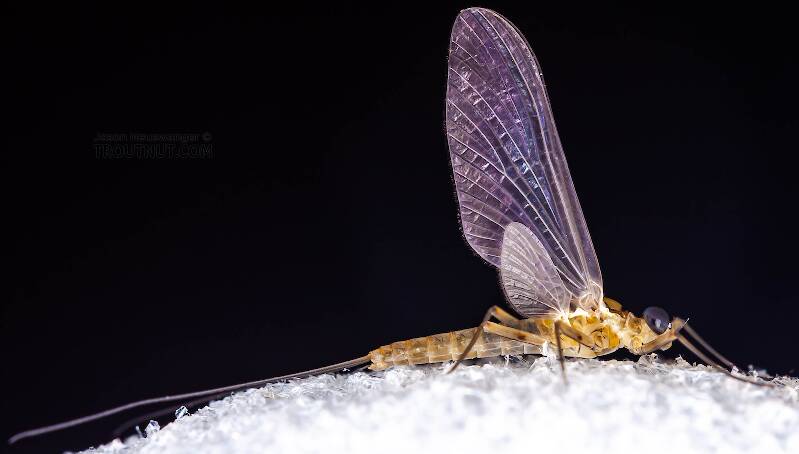
Blue-winged Olives
Baetis
Tiny Baetis mayflies are perhaps the most commonly encountered and imitated by anglers on all American trout streams due to their great abundance, widespread distribution, and trout-friendly emergence habits.
Featured on the forum

Some characteristics from the microscope images for the tentative species id: The postero-lateral projections are found only on segment 9, not segment 8. Based on the key in Jacobus et al. (2014), it appears to key to Neoleptophlebia adoptiva or Neoleptophlebia heteronea, same as this specimen with pretty different abdominal markings. However, distinguishing between those calls for comparing the lengths of the second and third segment of the labial palp, and this one (like the other one) only seems to have two segments. So I'm stuck on them both. It's likely that the fact that they're immature nymphs stymies identification in some important way.

Troutnut is a project started in 2003 by salmonid ecologist Jason "Troutnut" Neuswanger to help anglers and
fly tyers unabashedly embrace the entomological side of the sport. Learn more about Troutnut or
support the project for an enhanced experience here.

Troutnut on Oct 3, 2006October 3rd, 2006, 6:22 pm EDT
This Epeorus species was the only significant hatch I encountered in the remote headwaters of a Catskill stream one afternoon (September 6th, 2006). The small stream is incredibly clear and reportedly very acidic. The duns were coming off sporadically all afternoon and evening on this pleasantly warm, mostly cloudy day with a fleeting dash of rain at one point and sunshine at another. The female spinners were around the whole time but were much more common over the riffles toward evening in groups of 2-10. They were diving to the surface to lay eggs by quickly dipping their abdomens into the water and rising up again for a repeated run.
I couldn't find any male spinners, which might make identification impossible, but I did photograph the following:
Hopefully this will be enough to eventually puzzle out the ID of this pretty little species.
I couldn't find any male spinners, which might make identification impossible, but I did photograph the following:
Hopefully this will be enough to eventually puzzle out the ID of this pretty little species.
Jason Neuswanger, Ph.D.
Troutnut and salmonid ecologist
Troutnut and salmonid ecologist
GONZO on Oct 4, 2006October 4th, 2006, 8:30 am EDT
You've got a tough one here, Jason. It certainly seems to conform to Epeorus except that the eyes of the male are not truly contiguous.
I've had a look at the NY collecting record and it's not much help. The recorded candidate species are E. fragilis, frisoni, suffusus, punctatus. The latter three seem quite rare, with the only US records coming from a few counties in NY. Only fragilis is recorded outside NY in the US records (ME & CT). None of these are previously recorded from the Catskills.
Curiously, the new report (published 2001) of frisoni is the first "since its description (Burks 1946) from one locality in Maine," but the original report does not seem to be included in the current ME record.
I've had a look at the NY collecting record and it's not much help. The recorded candidate species are E. fragilis, frisoni, suffusus, punctatus. The latter three seem quite rare, with the only US records coming from a few counties in NY. Only fragilis is recorded outside NY in the US records (ME & CT). None of these are previously recorded from the Catskills.
Curiously, the new report (published 2001) of frisoni is the first "since its description (Burks 1946) from one locality in Maine," but the original report does not seem to be included in the current ME record.
Troutnut on Oct 4, 2006October 4th, 2006, 8:58 am EDT
Yeah, the distribution records tend to be very incomplete, especially for the less common species. It's useful to see some places where a species is present, but the lack of a record doesn't necessarily mean a species is not present.
I don't worry too much about the slightly non-contiguous eyes. For one thing, it's a dun -- perhaps the eyes are compressed a bit and they'll fully expand in the spinner form. For another, even the Epeorus pleuralis spinner I collected this spring doesn't have eyes that actually touch. They're a bit closer than in this specimen, but there is a gap. I might be wrong here, but I think we can count them as contiguous if they're separated by less than the width of the median ocellus.
Other reasons I'm confident it's Epeorus:
I don't have any good papers on Epeorus species identification. Have you seen any cited that looked intriguing? I can find just about any entomology paper at the Cornell library, but for some genera there's not much to go by beyond very old keys and original species descriptions.
I don't worry too much about the slightly non-contiguous eyes. For one thing, it's a dun -- perhaps the eyes are compressed a bit and they'll fully expand in the spinner form. For another, even the Epeorus pleuralis spinner I collected this spring doesn't have eyes that actually touch. They're a bit closer than in this specimen, but there is a gap. I might be wrong here, but I think we can count them as contiguous if they're separated by less than the width of the median ocellus.
Other reasons I'm confident it's Epeorus:
- The first two segments of the fore tarsi are the same length.
- The basal costal crossveins slant upward.
- The wings are unmarked.
I don't have any good papers on Epeorus species identification. Have you seen any cited that looked intriguing? I can find just about any entomology paper at the Cornell library, but for some genera there's not much to go by beyond very old keys and original species descriptions.
Jason Neuswanger, Ph.D.
Troutnut and salmonid ecologist
Troutnut and salmonid ecologist
Troutnut on Oct 4, 2006October 4th, 2006, 2:02 pm EDT
I verified in Merritt & Cummins that the identifying characteristic for Epeorus males is that the eyes are "touching or separated by less than the width of the median ocellus." So these eyes are consistent with that genus too.
Jason Neuswanger, Ph.D.
Troutnut and salmonid ecologist
Troutnut and salmonid ecologist
GONZO on Oct 5, 2006October 5th, 2006, 8:40 am EDT
The wings are much darker than any vitreus I have ever seen; so until someone can suggest a good guide to other Epeorus species, I think it will have to remain a "mystery" Epeorus sp.
Entoman on May 9, 2012May 9th, 2012, 12:11 pm EDT
Jason,
It's not mentioned how this determination was arrived at, but I think it's a good one. Here's a quote out of Burian '08:
In the key provided in the paper, being less than 6.80mm is listed as a diagnostic character for fragilis.
As to possible confusion with vitreus, besides time of year and habitat, your excellent photos show the clear differences between the two sets of genitalia. With vitreus, the second clasper seg. is substantially longer than the terminal seg. Also, the penes are elongate. These characters are unique to vitreus (in this genera) and are in stark contrast with the other species. Even though it's a sub, your photos clearly show the opposite with longer terminal segs and short penes (as characteristic of frisoni). The differences are so dramatic, I think it reasonable to assume that molting wouldn't reverse this. A caveat that should be mentioned is the paper stresses that much needs to be resolved with this genus and that many characters relied on for diagnosis will probably need revision for use outside of New England. Even so, I doubt the species will swap genitalia. :)
It's not mentioned how this determination was arrived at, but I think it's a good one. Here's a quote out of Burian '08:
Male imagos of E. frisoni can be easily separated from E. pleuralis and E. vitreus not only by emergence time, but also body size, color and type of genitalia. Male imagos of E. frisoni, despite the overlap of emergence time and sympatry with E. fragilis, can be easily separated from those of E. fragilis by: larger body size (8.17 — 9.55mm);
In the key provided in the paper, being less than 6.80mm is listed as a diagnostic character for fragilis.
As to possible confusion with vitreus, besides time of year and habitat, your excellent photos show the clear differences between the two sets of genitalia. With vitreus, the second clasper seg. is substantially longer than the terminal seg. Also, the penes are elongate. These characters are unique to vitreus (in this genera) and are in stark contrast with the other species. Even though it's a sub, your photos clearly show the opposite with longer terminal segs and short penes (as characteristic of frisoni). The differences are so dramatic, I think it reasonable to assume that molting wouldn't reverse this. A caveat that should be mentioned is the paper stresses that much needs to be resolved with this genus and that many characters relied on for diagnosis will probably need revision for use outside of New England. Even so, I doubt the species will swap genitalia. :)
"It's not that I find fishing so important, it's just that I find all other endeavors of Man equally unimportant... And not nearly as much fun!" Robert Traver, Anatomy of a Fisherman
Troutnut on May 9, 2012May 9th, 2012, 1:25 pm EDT
There's a lot of back-story on this determination, and it's still not fully settled. Luke (Konchu) actually had an associate collect nymphs to rear to adults from the stream where I got these specimens, and they did a genetic analysis. The results are still inconclusive.
Jason Neuswanger, Ph.D.
Troutnut and salmonid ecologist
Troutnut and salmonid ecologist
Entoman on May 9, 2012May 9th, 2012, 4:48 pm EDT
Ah! I'd like to hear the explanation... It's going to be interesting to see where taxonomy is in a few years. Improving technology coupled with increasing understanding of the diversity that can exist within the concept of a species is going to result in a lot of fascinating stuff! In the meantime I guess all we can do is use the best information that's currently available. One of the great things about the Troutnut Encyclopedia is as the entomological community comes up with newer taxonomies it can be updated.:)
"It's not that I find fishing so important, it's just that I find all other endeavors of Man equally unimportant... And not nearly as much fun!" Robert Traver, Anatomy of a Fisherman
Quick Reply
Related Discussions
Topic
Replies
Last Reply
1
Oct 19, 2006
by Troutnut
by Troutnut
0
Oct 24, 2006
by Troutnut
by Troutnut
1
Apr 8, 2009
by Troutnut
by Troutnut
0
May 3, 2007
by Troutnut
by Troutnut
1
Oct 28, 2008
by GONZO
by GONZO



